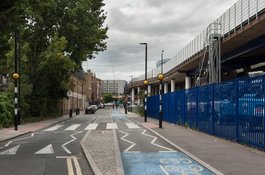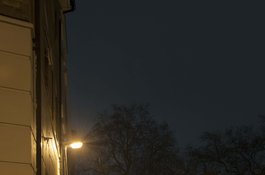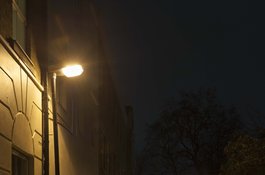From Graces Alley to Cable Street
Contributed by Survey of London on Dec. 7, 2018
The alley from the north-west corner of Marine Square was first called Boat
Alley in 1683. Felix Calverd, a brewer, tax farmer and Fire Office trustee
associate of Nicholas Barbon (who undertook the development of Wellclose
Square), was then assigned the superior interest of the frontages. Leases were
given to Francis Hooper for the east end of the north side, Charles Armistead,
west end of the north side, and William Blackwell, south side. Building work
was doubtless slow to get underway, but in early 1694 Calverd was taxed for
eight empty houses at Well Close. George Jackson, a City bricklayer, built at
least two 14ft-frontage houses on the alley’s south side in 1694–5 under a
lease from Calverd to Edward Wright, a Clerkenwell glazier.
By 1720, with its frontages fully built up with ten houses on each side, Boat
Alley had come to be known as Graces Alley, a reference to the former abbey of
St Mary Grace that had stood on the site later occupied by the Royal Mint.
Next to Wellclose Square on the north side at 1 Graces Alley was the George
Prince of Denmark’s Head, or Prince of Denmark public house, the name a nod to
the square’s Danish church and occupancy – Prince George of Denmark and
Norway, Queen Anne’s husband, died in 1708. This pub was part of Hooper’s
block of ten houses which passed to Benjamin Collyer, a Surrey merchant. In
1732 John Harper, a citizen needlemaker, was given a new lease of the whole
row on the north side of Graces Alley to run to 1805. Soon thereafter Collyer
was obliged to sell and by the 1770s part of a larger property, which also
included fifteen houses along the south side of Cable Street, was divided in
the ownerships of Edmund Probyn, William Coward and the Duke of Bridgewater.
Leases were co-ordinated to fall in together in 1805.
John Yarrem, a silversmith and hardware dealer or toyman, was at 4 Graces
Alley by 1760. In the years around 1800, Benjamin Abrahams, a slop (clothing)
seller, was at No. 2 and George Holding, a confectioner at No. 3. In December
1807 Probyn, the Earl of Bridgewater and Ann Jemima Wroughton issued new
leases for the unusual term of 46 years; it is not clear that rebuilding was
expected. William Marsh, a publican, took 1–2 Graces Alley, the former
continuing as the Prince of Denmark. Holding and Yarrem’s son, also John,
continued respectively at Nos 3 and 4, which appear both, like the alley’s
other houses, to have been two full rooms deep at this juncture.
Shop use was general along both sides of the alley through the nineteenth
century. After many years as an empty site, 7–8 Graces Alley were rebuilt in
1897–8. The American Stores beer house was at No. 10 in the decades either
side of 1900, and the Royal Standard public house was at the west end of the
south side, on the Well (Ensign) Street corner.
Up to the 1960s the stretch of Cable Street immediately north between Well
Street and Fletcher Street had a row of around twenty early- and mid-
nineteenth-century three-storey shophouses, which included the Bricklayers’
Arms at No. 26, and the Admiral Blakeney’s Head at No. 56 on the Fletcher
Street corner. When general clearance of Graces Alley and both sides of this
stretch of Cable Street was programmed in the early 1960s, the houses on the
south side of the alley had already been demolished. Particular complaints
were made about an unlicensed club at 7–8 Graces Alley, owned by George
Gavrilides and frequented by ‘coloured men’. Clearance of all but 1–4 Graces
Alley and what had been Wilton’s Music Hall ensued by 1968.


